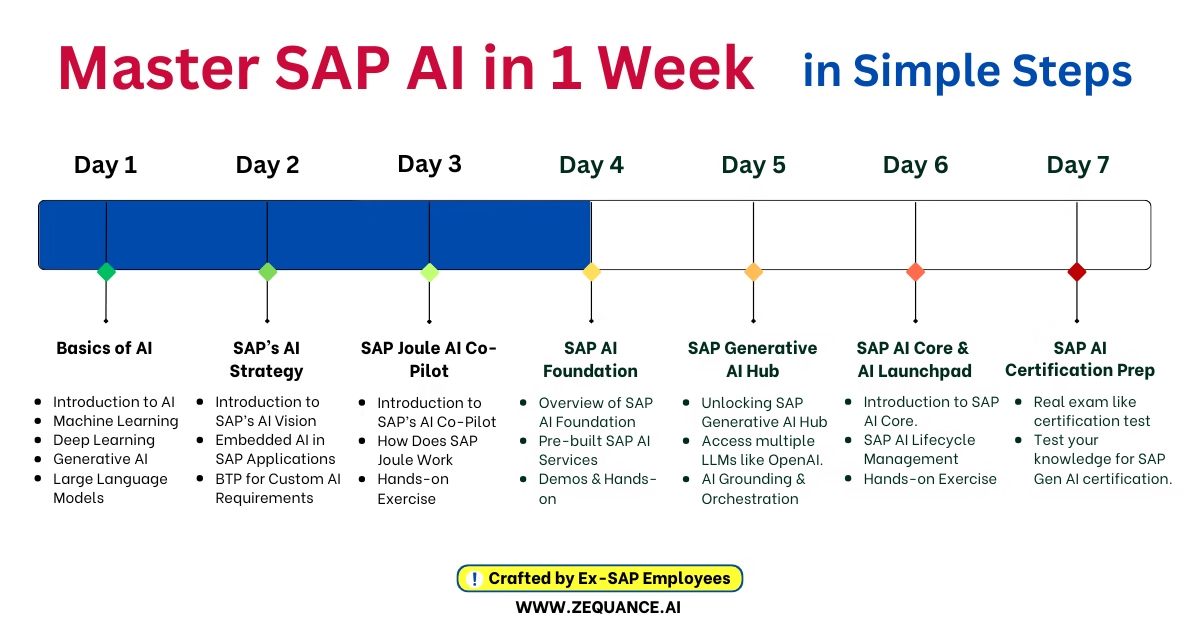Understanding Joule Setup for SAP S/4HANA Cloud: A Decision-Maker’s Guide
Introduction: Meet Your New AI Co-Pilot
Imagine having a smart assistant that knows your SAP system inside out—one that can instantly find the right app for your task, pull up critical business data in seconds, and guide you through complex processes. That’s SAP Joule, SAP’s AI copilot for S/4HANA Cloud Public Edition.
But here’s the question most decision-makers ask: “What does it actually take to get this running?”
Let’s demystify the setup process and help you understand what’s involved, without drowning in technical details.
What Can Joule Actually Do?
Before we talk setup, let’s be clear about what you’re getting:
- Quick Navigation: Think of it as a smart search that understands intent. Ask “create a purchase order” and Joule takes you straight to the right application.
- Instant Insights: Get answers about your business data—purchase orders, outbound deliveries, sales data—without navigating through multiple screens.
- Contextual Help: Stuck on a task? SAP Joule summarizes relevant help content and guides you to the right resources.
The key word here is contextual. SAP Joule understands who you are, what roles you have, and what you’re allowed to see. It’s not just generic AI—it’s your company’s AI assistant.
The Big Picture: How Does This All Work?
Here’s the interesting part: SAP Joule isn’t just installed on your S/4HANA system. It’s actually an orchestration of several SAP technologies working together.

Think of it like a well-coordinated team:
The Core Players
1. SAP Business Technology Platform (BTP)
This is where Joule lives. BTP is SAP’s cloud platform that brings together data, analytics, and AI capabilities. For Joule to work, you need:
- A BTP subaccount (think of it as your dedicated workspace in the cloud)
- Cloud Foundry environment (the runtime environment)
- The Joule service itself
2. SAP Build Work Zone
This might surprise you—Joule needs Work Zone to understand your application landscape. Why? Because Work Zone acts as the central hub that knows:
- Which Fiori apps exist in your system
- Who has access to what
- How apps are organized into catalogs and roles
3. SAP Cloud Identity Services
This is your security gatekeeper. It handles:
- User authentication (making sure people are who they say they are)
- Identity provisioning (syncing users and their permissions)
- Single sign-on across all systems
4. Your S/4HANA Cloud System
Of course, this is where your actual business data lives. The system needs to be configured to expose its content and communicate securely with the other components.
The Setup Journey: What Actually Happens?
Let’s walk through the setup at a conceptual level—not the technical steps, but what’s really happening behind the scenes.
Phase 1: Laying the Foundation
First, you establish the connections. This is like setting up secure communication channels between different departments:
- BTP gets connected to your S/4HANA system: Special communication arrangements (think secure APIs) are created so the systems can talk to each other
- Identity services are configured: Your Cloud Identity Services tenant gets linked to both BTP and S/4HANA
- Work Zone is activated: This becomes your content hub
SAP provides a “booster” tool that automates much of this initial setup. It’s like having an installation wizard that creates the basic infrastructure for you.
Phase 2: Content Exposure
This is where things get interesting. Your S/4HANA system needs to tell Work Zone about its content:
- Business roles are exposed: The system shares information about which roles exist (like Purchaser, Sales Manager, etc.)
- Fiori apps are cataloged: Every application, along with its purpose and who can access it, gets synced to Work Zone
- User assignments are replicated: The system keeps track of which users have which roles
Think of this as creating a detailed map of your application landscape that Joule can reference.
Phase 3: Identity Synchronization
Here’s a critical piece: keeping users and permissions in sync. Through Identity Provisioning Service (IPS), the setup ensures that:
- User accounts are synchronized across systems
- Role assignments are kept up-to-date
- When someone gets new permissions in S/4HANA, Joule knows about it
This isn’t a one-time sync—it needs to run regularly to stay current.
Phase 4: Security Configuration
Finally, the systems need to trust each other:
- Content Security Policies are updated: Your S/4HANA system is configured to allow Joule’s interface to load
- Authentication flows are established: Users can move seamlessly between S/4HANA and Joule without multiple logins
- Certificates and destinations are verified: The secure communication channels are tested and validated
What SAP Provides vs. What You Configure
SAP Gives You:
- The Joule AI service and underlying technology
- Pre-built boosters to automate initial setup
- Standard communication scenarios and APIs
- Built-in capabilities for specific business objects (purchase orders, sales orders, etc.)
- Regular updates and new features
You Need to Configure:
- Which business roles to expose to Joule.
- User assignments and permissions.
- Connection details between your specific systems.
- Authentication methods (especially if you use third-party identity providers like Azure or Okta).
- Regular synchronization jobs.
The Architecture in Simple Terms
Imagine a user asking Joule: “Show me purchase orders for Plant 1010”

Here’s what happens in seconds:
- Authentication Check: Cloud Identity Services verifies who the user is and what roles they have
- Intent Recognition: Joule’s AI understands the user wants to see purchase order data
- Permission Validation: The system checks if this user’s roles include access to purchase order information
- Navigation Lookup: Work Zone provides the correct Fiori app for purchase orders
- Data Retrieval: S/4HANA is queried for the specific data (only what the user is authorized to see)
- Response: Joule presents the information in a conversational format
All of this happens through secure, authenticated API calls across the different components.
Key Considerations for Decision-Makers
1. This Is a Multi-System Setup
You’re not just installing a feature—you’re connecting multiple SAP cloud services. Each needs to be properly configured and maintained.
2. Separate Setup Per Environment
Joule needs to be set up independently for each system (test, production, etc.). The configurations can’t be transported like traditional SAP customizing.
3. Ongoing Maintenance Required
User and role synchronization jobs need to run regularly. Content exposure needs to be maintained as you add new roles or applications.
4. Data Center Availability Matters
Joule is only available in specific SAP data centers. You’ll need to ensure your BTP subaccount is in a supported region.
Is Your Organization Ready?
Ask yourself these questions:
- Do we have the necessary entitlements (Joule, Work Zone, Cloud Identity Services)?
- Is our BTP environment in a supported data center for Joule?
- Do we have resources comfortable with both BTP and S/4HANA Cloud administration?
- Have we documented our current role structure and which roles should have Joule access?
- If we use a third-party identity provider, is it properly integrated with SAP Cloud Identity Services?

The Bottom Line
Joule for S/4HANA Cloud is powerful, but it’s not a simple plugin. It’s an integration project that brings together multiple SAP technologies into a cohesive AI-powered experience.
The good news? SAP has done a lot of work to streamline the setup with automated boosters and clear documentation. The architecture is well-thought-out, with proper security and authorization at every layer.
For organizations already running S/4HANA Cloud and comfortable with SAP’s cloud ecosystem, Joule represents a genuine productivity boost. Just go in with eyes open about the setup requirements, and plan accordingly.
The future of ERP interaction is conversational and AI-powered. Joule is SAP’s significant step in that direction—and now you understand what it takes to make it work.
P.S. 7 Easy Steps to Learn SAP AI. Checkout SAP AI Masterclass on Udemy. Crafted by Ex-SAP Employees.



